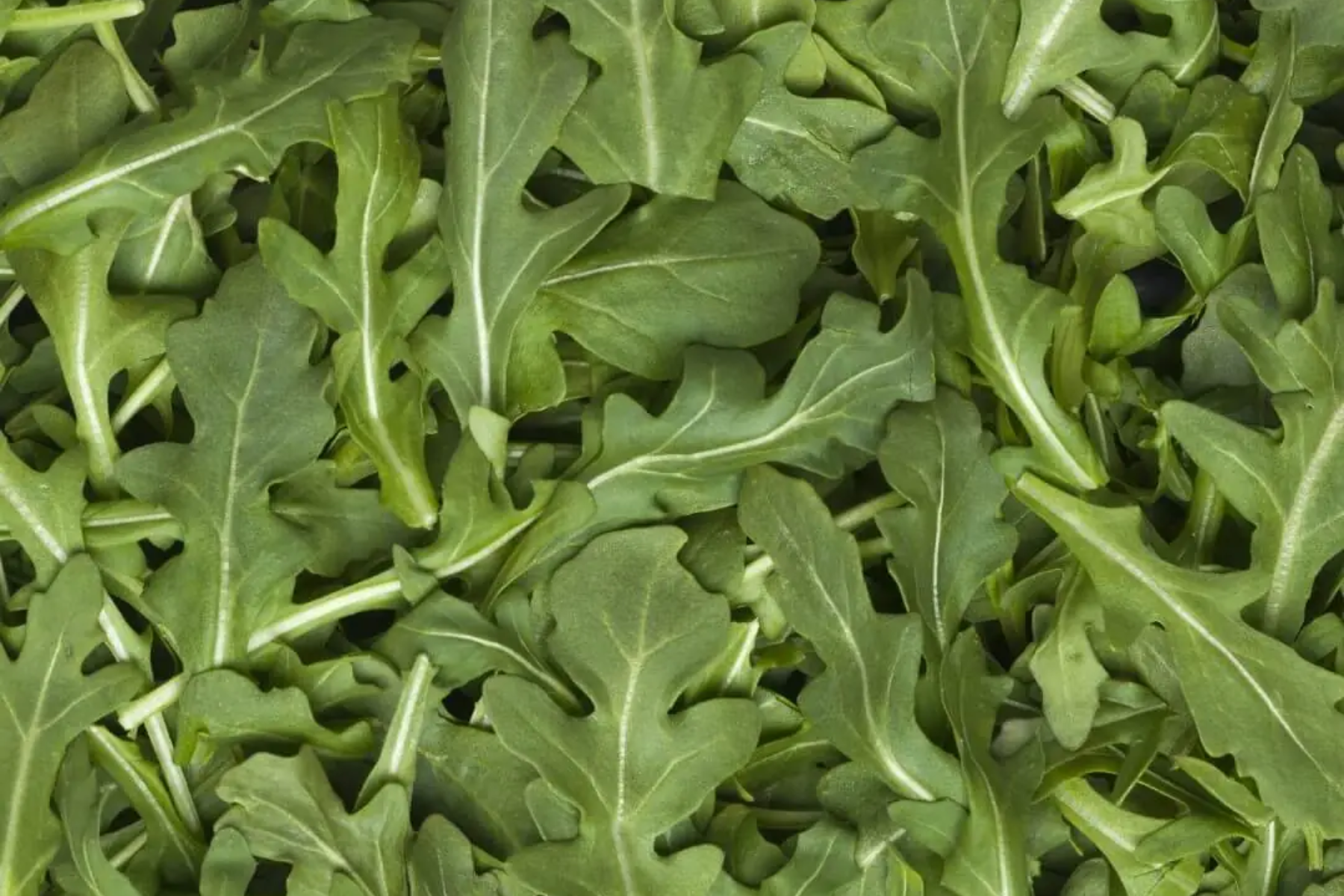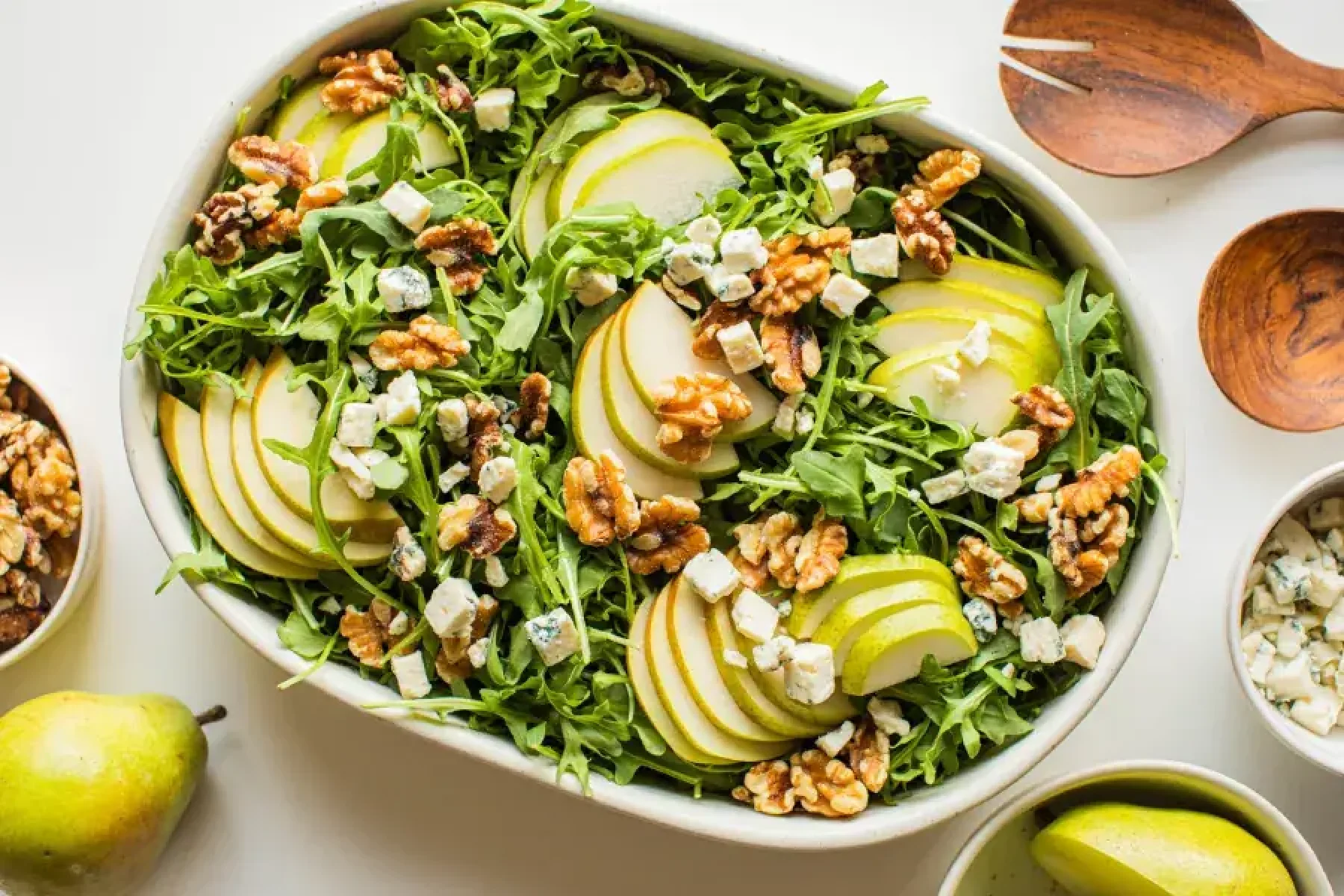Arugula is far from your average leafy green. Small in size but big on flavor, arugula is a nutrient-packed powerhouse that’s always ready to add a delightful peppery kick to your dishes.
Let’s look more into the health benefits of arugula, answer some common questions about what nutrients it has, and find out why it should have a prominent place in your diet.

What is the Nutritional Value of Arugula?
Arugula has a surprisingly rich nutritional profile, with a variety of vitamins and minerals essential for your daily health. It’s very high in vitamins A, C, and K.
- Vitamin A supports vision and immune function
- Vitamin C acts as an antioxidant that protects cells
- Vitamin K is crucial for blood clotting and bone health.
Arugula also provides decent amounts of folate, calcium, magnesium, and potassium. Not bad, right?
What is the Nutritional Difference Between Arugula and Spinach?
Arugula and spinach, while both very nutritious greens, have some pretty distinct differences in their nutrient profiles. For instance, arugula tends to be higher in vitamin C and vitamin K. On the other hand, spinach is known for its higher iron content. But it’s not like you have to choose one over the other — both greens offer valuable health benefits and can easily complement each other in a balanced diet.
Does Arugula Have Fiber?
Yes, arugula is a source of dietary fiber, which is essential for your digestive system. One serving of arugula contains almost a gram of fiber. Including fiber-rich foods like arugula in your diet supports overall gastrointestinal health and helps maintain proper cholesterol levels. Fiber also helps you feel fuller for longer!
Does Cooking Arugula Affect Its Nutritional Benefits?
Yes, but only a bit. Lightly cooking arugula — such as steaming or sautéing — can slightly reduce its vitamin C content due to the little leaves’ heat sensitivity. However, arugula retains most of its nutrients when cooked gently, making it a versatile ingredient for lots of different culinary preparations. So, don’t you worry: Whether raw in salads or cooked in dishes, arugula is always a nutritious choice. And it’s also fun to say out loud.
How Does Arugula Compare to Romaine Lettuce Nutritionally?
Arugula and romaine lettuce offer some fairly distinct nutritional benefits. Romaine lettuce is higher in vitamin A and folate, which are important for vision and cell function. Arugula, on the other hand, provides more vitamin C and calcium per serving. Both greens are low in calories and rich in antioxidants, making them valuable additions to a healthy diet.
Is Arugula a Good Source of Potassium?
Yes! While it doesn’t have as much as, say, a banana, arugula does contain a good amount of potassium, an essential mineral that supports heart health and muscle function. One serving of arugula contains about 150 mg of potassium. Potassium also helps regulate blood pressure and electrolyte balance in the body. Including potassium-rich foods like arugula in your meals can help maintain cardiovascular health and prevent muscle cramps.
What Vitamins Does Arugula Have?
Arugula is particularly rich in vitamins A, C, and K. Vitamin A supports vision and immune function, vitamin C acts as an antioxidant that protects against oxidative stress, and vitamin K is essential for blood clotting and bone health. These vitamins work synergistically to support your overall health and well-being. Just feel the synergy!
Does Arugula Provide Iron?
Yes, arugula does contain a small amount of iron. The iron in arugula is non-heme iron, which is less easily absorbed by the body compared to heme iron found in animal products. Pairing arugula with vitamin C-rich foods can enhance iron absorption (for example, topping your arugula salad with tomatoes or blueberries).
Including Arugula in Your Diet
Now that we’ve explored the nutritional benefits of arugula, it’s time to look at some delicious ways to incorporate this nutrient-rich green into your meals:

Arugula in Salads
Create a refreshing salad by mixing freshly packaged arugula with cherry tomatoes, cucumber slices, red onion, and a lemony vinaigrette. Then add some grilled chicken, salmon, or chickpeas for an easy protein boost. Looking for something a little different? Try combining sliced pears, blue cheese, and walnuts on top of fresh arugula for a slightly sweet Pear Arugula Salad recipe.
Arugula in Sandwiches
Use arugula as a flavorful addition to sandwiches and wraps! For example, pair it with roasted vegetables, avocado, and a spread of hummus or pesto for a satisfying lunch option.
Arugula in Pasta Dishes
Adding arugula is an easy way to elevate simple pasta dishes into something memorable. Toss cooked pasta with arugula, olive oil, garlic, and Parmesan cheese for a quick and nutritious meal that’s a welcome break from the ordinary. If you want to go even further, incorporate pine nuts, sun-dried tomatoes, or grilled shrimp for more added flavor and texture.
Speaking of pine nuts, did you know you can use arugula to make pesto?
Here’s a simple arugula pesto recipe you can try out:
Ingredients:
- 2 cups fresh arugula, packed
- 1/2 cup grated Parmesan cheese
- 1/2 cup extra virgin olive oil
- 1/3 cup pine nuts (or walnuts)
- 2 cloves garlic
- 1/2 teaspoon salt
- 1/4 teaspoon black pepper
- Juice of 1/2 lemon (optional)
Directions:
- Prepare Ingredients: Wash and dry the arugula leaves.
- Blend Nuts and Garlic: In a food processor, pulse the pine nuts and garlic until finely chopped.
- Add Arugula and Cheese: Add the arugula and Parmesan cheese, and pulse a few more times until combined.
- Stream in Olive Oil: With the processor running, slowly add the olive oil until the mixture is smooth and well combined.
- Season: Add salt, pepper, and lemon juice (if using). Pulse to mix.
- Adjust Consistency: If the pesto is too thick, add a bit more olive oil until you’ve reached your desired consistency.
- Store: Transfer to a jar and refrigerate. It can be stored for up to a week!
Arugula as a Pizza Topping
Sprinkle fresh arugula on top of pizza just before serving for a vibrant and peppery twist that’s right at home on a fresh pie. Drizzle with balsamic glaze or a touch of olive oil for some extra depth of flavor.
More Arugula, Please!
So, there you have it. Arugula has a pretty impressive nutritional profile that makes it a versatile, valuable addition to any diet. And to make things even better, it’s delicious any way you use it! Whether enjoyed raw in salads or incorporated into cooked dishes, arugula offers a good mix of vitamins, minerals, and antioxidants that support your overall health and well-being.
So, next time you’re planning your meals or shopping for groceries, make sure you grab some arugula so you can savor its robust & peppery presence while your body benefits from its substantial amount of nutrients.
